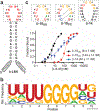Inverse In Vitro Selection Enables Comprehensive Analysis of Cross-Chiral L-Aptamer Interactions
- PMID: 36282114
- PMCID: PMC9798143
- DOI: 10.1002/cbic.202200520
Inverse In Vitro Selection Enables Comprehensive Analysis of Cross-Chiral L-Aptamer Interactions
Abstract
Aptamers composed of mirror-image L-(deoxy)ribose nucleic acids, referred to as L-aptamers, are a promising class of RNA-binding reagents. Yet, the selectivity of cross-chiral interactions between L-aptamers and their RNA targets remain poorly characterized, limiting the potential utility of this approach for applications in biological systems. Herein, we carried out the first comprehensive analysis of cross-chiral L-aptamer selectivity using a newly developed "inverse" in vitro selection approach that exploits the genetic nature of the D-RNA ligand. By employing a library of more than a million target-derived sequences, we determined the RNA sequence and structural preference of a model L-aptamer and revealed previously unidentified and potentially broad off-target RNA binding behaviors. These results provide valuable information for assessing the likelihood and consequences of potential off-target interactions and reveal strategies to mitigate these effects. Thus, inverse in vitro selection provides several opportunities to advance L-aptamer technology.
Keywords: In vitro selection; L-aptamers; RNA; selectivity; sequencing.
© 2022 Wiley-VCH GmbH.
Figures




Similar articles
-
An improved SELEX technique for selection of DNA aptamers binding to M-type 11 of Streptococcus pyogenes.Methods. 2016 Mar 15;97:51-7. doi: 10.1016/j.ymeth.2015.12.005. Epub 2015 Dec 8. Methods. 2016. PMID: 26678795
-
Characterisation of aptamer-target interactions by branched selection and high-throughput sequencing of SELEX pools.Nucleic Acids Res. 2015 Dec 2;43(21):e139. doi: 10.1093/nar/gkv700. Epub 2015 Jul 10. Nucleic Acids Res. 2015. PMID: 26163061 Free PMC article.
-
Development of RNA G-quadruplex (rG4)-targeting L-RNA aptamers by rG4-SELEX.Nat Protoc. 2022 Jun;17(6):1385-1414. doi: 10.1038/s41596-022-00679-6. Epub 2022 Apr 20. Nat Protoc. 2022. PMID: 35444329 Review.
-
Rapid identification of cell-specific, internalizing RNA aptamers with bioinformatics analyses of a cell-based aptamer selection.PLoS One. 2012;7(9):e43836. doi: 10.1371/journal.pone.0043836. Epub 2012 Sep 4. PLoS One. 2012. PMID: 22962591 Free PMC article.
-
Development of Better Aptamers: Structured Library Approaches, Selection Methods, and Chemical Modifications.Angew Chem Int Ed Engl. 2024 Apr 15;63(16):e202318665. doi: 10.1002/anie.202318665. Epub 2024 Feb 16. Angew Chem Int Ed Engl. 2024. PMID: 38253971 Review.
Cited by
-
RNA-Based Sensor Systems for Affordable Diagnostics in the Age of Pandemics.ACS Synth Biol. 2024 Apr 19;13(4):1026-1037. doi: 10.1021/acssynbio.3c00698. Epub 2024 Apr 8. ACS Synth Biol. 2024. PMID: 38588603 Free PMC article. Review.
-
Cross-chiral exponential amplification of an RNA enzyme.Proc Natl Acad Sci U S A. 2024 Oct 29;121(44):e2413668121. doi: 10.1073/pnas.2413668121. Epub 2024 Oct 22. Proc Natl Acad Sci U S A. 2024. PMID: 39436654 Free PMC article.
References
-
- Guan L, Disney MD, ACS Chem. Biol 2012, 7, 73–86; - PubMed
- Shortridge MD, Varani G, Curr. Opin. Struct. Biol 2015, 30, 79–88; - PMC - PubMed
- Thomas JR, Hergenrother PJ, Chem. Rev 2008, 108, 1171–1224; - PubMed
- Velagapudi SP, Gallo SM, Disney MD, Nat. Chem. Biol 2014, 10, 292–297; - PMC - PubMed
- Pal S, ‘t Hart P, Front. Mol. Biosci 2022, 9; - PMC - PubMed
- Chen Y, Yang F, Zubovic L, Pavelitz T, Yang W, Godin K, Walker M, Zheng S, Macchi P, Varani G, Nat. Chem. Biol 2016, 12, 717–723; - PMC - PubMed
- Koirala D, Lewicka A, Koldobskaya Y, Huang H, Piccirilli JA, ACS Chem. Biol 2020, 15, 205–216. - PMC - PubMed
Publication types
MeSH terms
Substances
Grants and funding
LinkOut - more resources
Full Text Sources

